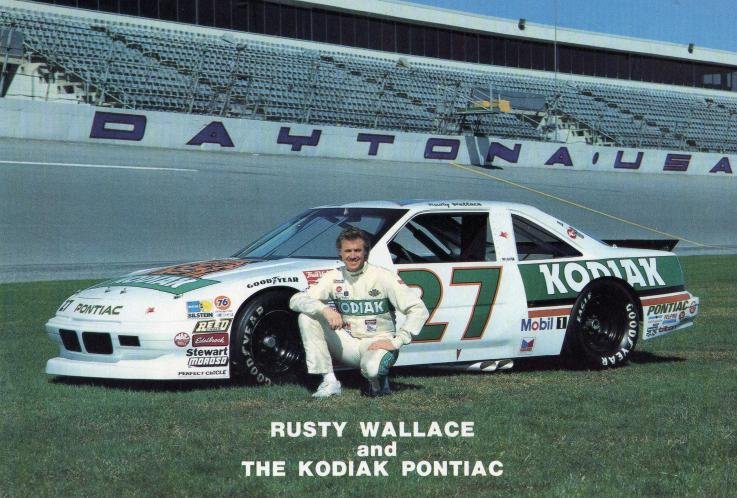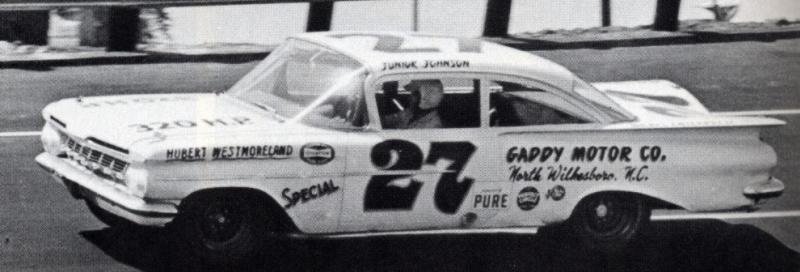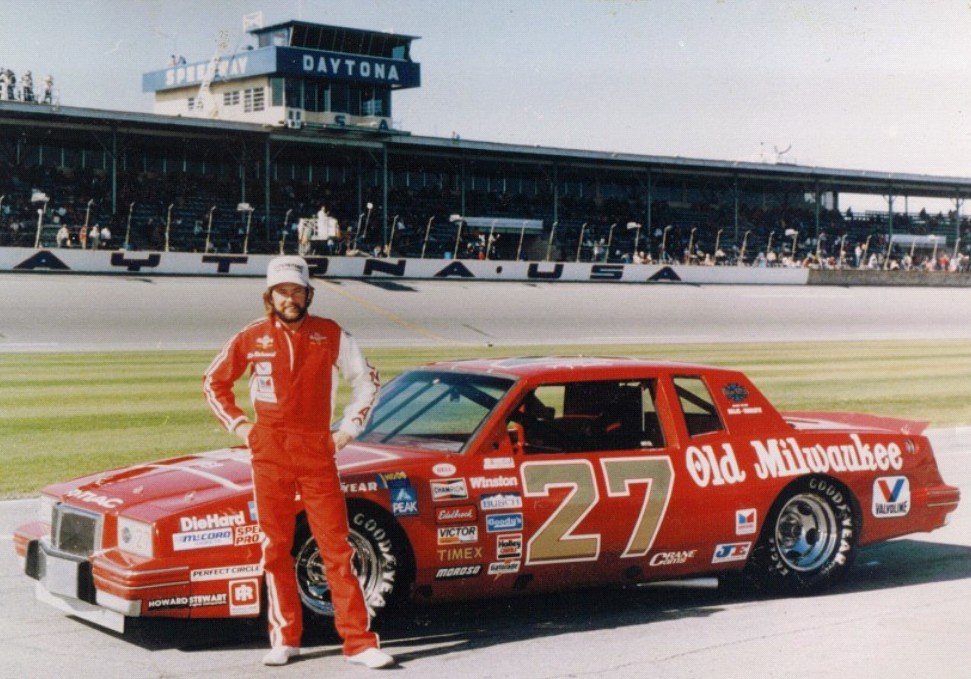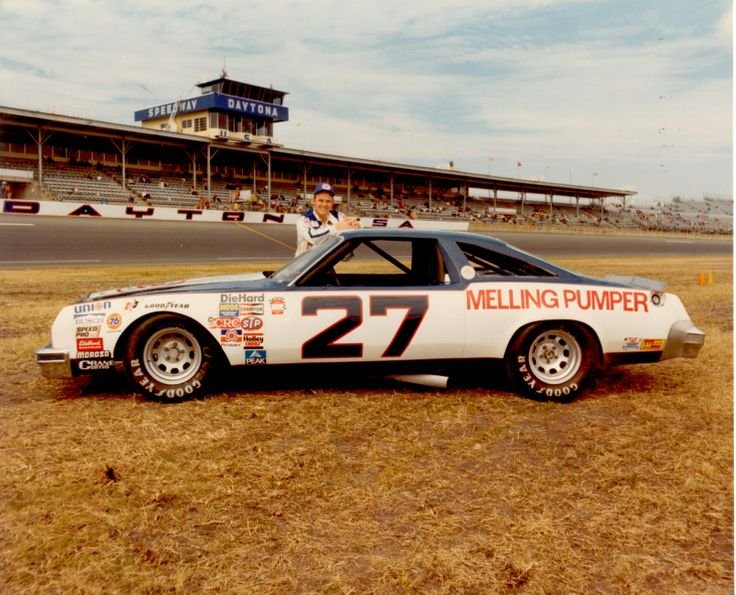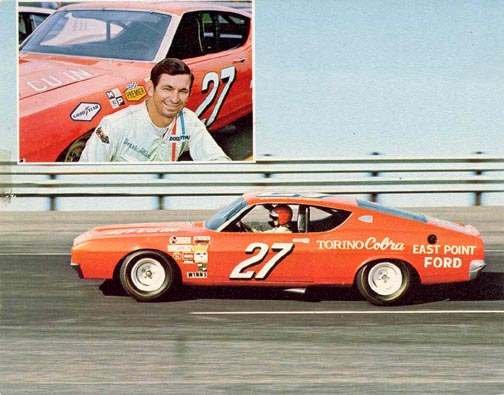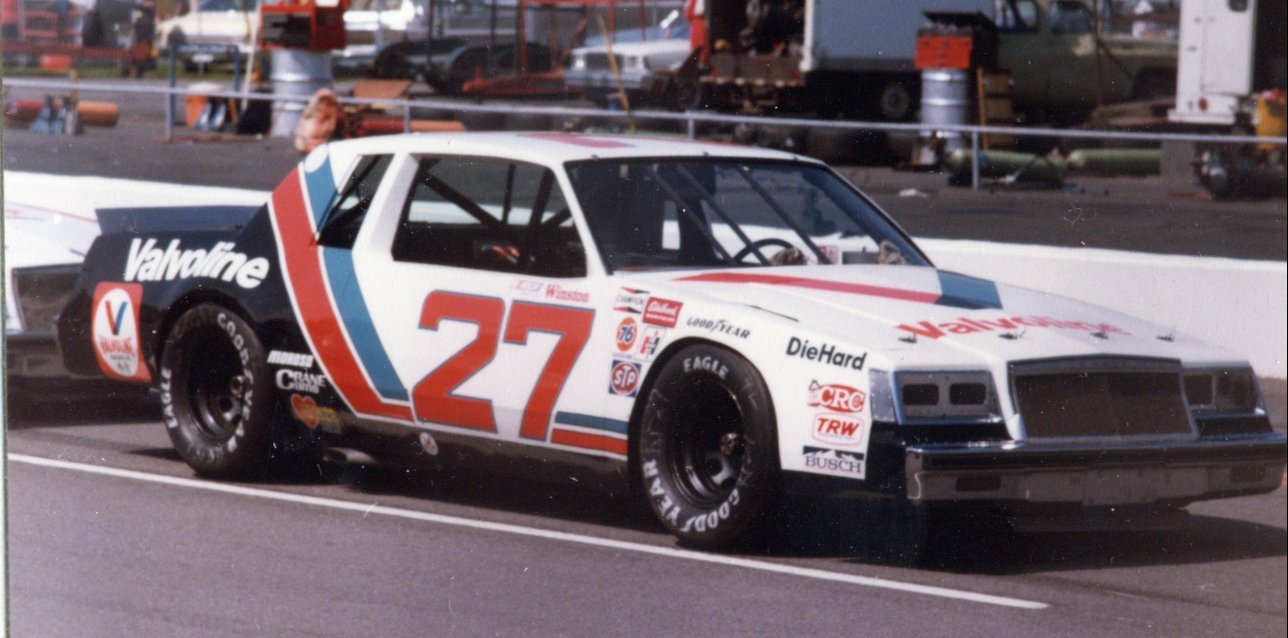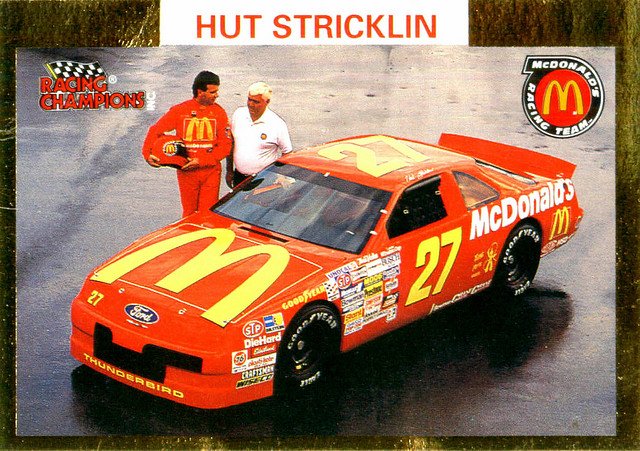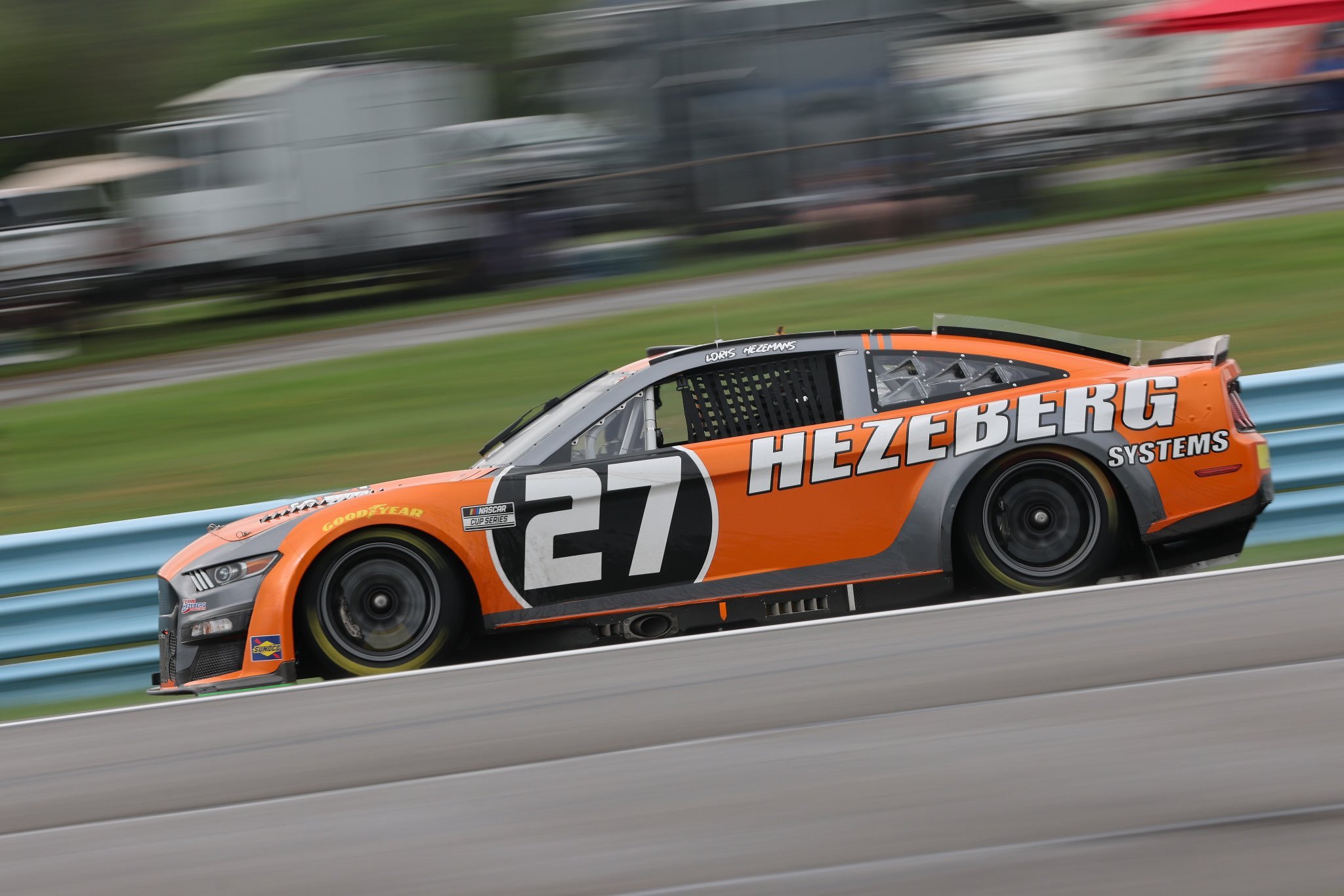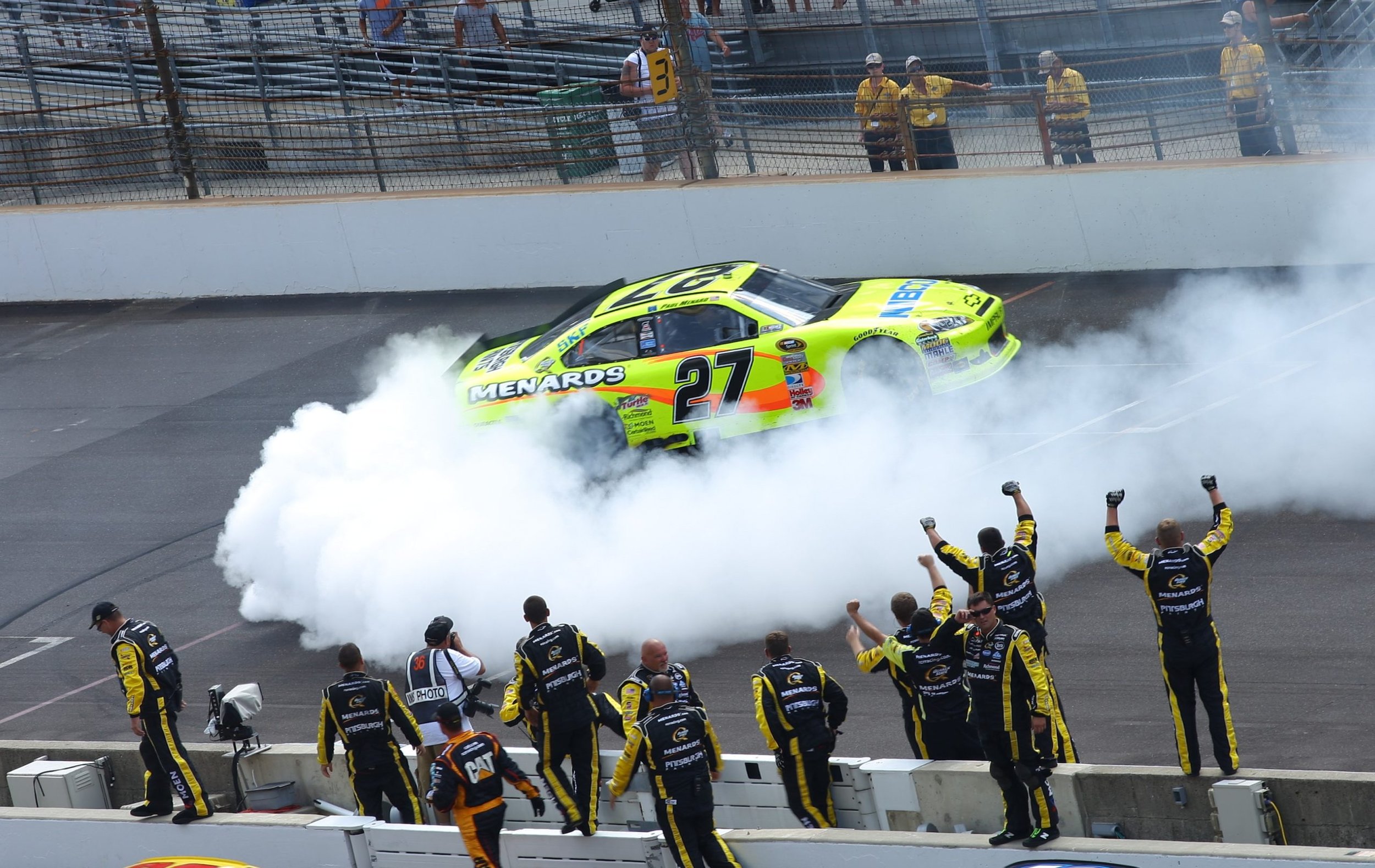
In NASCAR Cup Series competition the #27 car has started 1165 races with 88 drivers and has 52 wins, 46 poles, 227 top 5s, 398 top 10s, and 339 DNFs.
From 1986-1991 Rusty Wallace drove the #27 Alugard Pontiac for Raymond Beadle’s Blue Max Racing team. Rusty’s first win came on April 6, 1986, at Bristol Motor Speedway. He also won at Martinsville on September 21. Wallace finished 6th in the points, his first top 10 in the standings. For 1987 Wallace gained sponsorship from Kodiak , establishing the #27 Kodiak Pontiac livery his early career is most remembered for. He took victories at Watkins Glen and Riverside, as well first series pole at Michigan in June.
Wallace developed his career further in 1988 , scoring six victories including four of the final five races of the year. His wins came at Michigan, Charlotte, North Wilkesboro, Rockingham, the final race ever at Riverside , and the season finale at Atlanta. With these 6 wins he finished second to Bill Elliott by 24 points.
In 1989, Wallace won the NASCAR Winston Cup Championship , with crew chief Barry Dodson, by finishing 15th at the Atlanta Journal 500 at Atlanta Motor Speedway, to beating out close friend and fierce rival Dale Earnhardt who won the race, by twelve points. Wallace also won The Winston (All Star Race) in controversial fashion, by spinning out Darrell Waltrip on the last lap.
In 1990, Raymond Beadle switched sponsors, to Miller Genuine Draft. The four-year sponsorship deal was specifically tied to Wallace, meaning it went where the 1989 champ went. The 1989 championship year was reportedly marked with acrimony between Wallace and Beadle. However, Wallace was stuck with the team for 1990 due to his contract. Rusty had 18 wins for Beadle.
In 1991 Wallace took the Miller sponsorship with him to Penske Racing, and he continued in the #2 Miller Genuine Draft Pontiac. Rusty has the second most starts in #27 with 145.
Paul Menard has 252 starts and 1 win in the number since 2011. Menard has been driving in Cup since 2008 with Dale Earnhardt Inc., Robert Yates Racing, and Richard Petty Motorsports but found very little success before joining Richard Childress Racing in 2011. Menard has always been sponsored, at least in part, by Menard’s, the company his father owns.
On July 31, 2011, Menard won his first Cup race in his 167th start, in the Brickyard 400 at the prestigious Indianapolis Motor Speedway. He did so by making his last pit stop with 36 laps to go. He led late, but with 9 laps to go he was passed by Jamie McMurray. With four to go he regained the lead and held off Jeff Gordon, the winner of the inaugural Brickyard 400 in the final laps, having enough fuel to do so. He is the first member of the Menard family, or the first person driving sponsored by Menards to win at Indianapolis, in any event held at the track. He also joined Trevor Bayne, Regan Smith, David Ragan, and Marcos Ambrose as first-time winners in the 2011 season.
In September 2011 at Richmond, Menard and RCR became the center of controversy when Menard spun in the waning laps. It was believed that his accident was intentional, intended to assist his teammate Kevin Harvick who later won the race against Jeff Gordon who would have won if the caution did not come out.
In 2012, Menard did not perform well. And went winless. In 2013, he slightly improved when he was briefly in Chase for the Sprint Cup contention. A blown engine early in the Coke Zero 400 caused him to be knocked out of the Chase with a few races left before the Chase began. In the 2013 season-ending Ford EcoBoost 400, Menard’s tire exploded upon stopping in his pit box; Menard stated, “About a lap later, they told me I was on fire. I lost my brakes, and the damned wheel blew right off.”
Menard’s consistency faultered in 2015, as he only earned 5 top 10 finishes. However, he still made The Chase before being eliminated in the first round. 2016 saw Menard finish 25th in the standings with only 3 top 10 finished. After finishing 23rd in the 2017 standings, and only earning 3 top-10 finishes, exclusively at Restrictor Plate tracks, Menard & RCR parted ways. Menard retired from full-time racing following the 2019 season.
Junior Johnson started #27 98 times in his 313 career races, more than any other number. His first race in #27 came at the Daytona 500 in 1960. Johnson and his crew chief Ray Fox were practicing for the race, trying to figure out how to increase their speed, which was 22 miles per hour slower than the top cars in the race. During a test run a faster car passed Johnson. He noticed that when he moved behind the faster car his own speed increased due to the faster car’s slipstream. Johnson was then able to stay close behind the faster car until the final lap of the test run, when he used the “slipstream” effect to slingshot past the other car. By using this technique Johnson went on to win the 1960 Daytona 500, despite the fact that his car was slower than others in the field. Johnson’s technique was quickly adopted by other drivers, and his practice of “drafting” has become a common tactic in NASCAR races.
In 1963 he had a two-lap lead in the World 600 at Charlotte before a spectator threw a bottle onto the track and caused Junior to crash; he suffered only minor injuries. He retired from driving in 1966, but would go on to be a very successful car owner. In his career, he claimed 50 victories as a driver, and 11 of these wins were at major speedway races. He retired as the winningest driver never to have a championship.
Tim Richmond drove car #27 in 88 starts beginning in 1983 for Raymond Beadle whom he had known before he started racing. He returned to the three-cornered Pocono racetrack, site of his first career start in 1980, and earned his first oval victory. Esquire magazine named Richmond as one of “the best of the new generation” in 1984. That year he had one win at North Wilkesboro Speedway and second place finishes at Dover, Darlington and Riverside. Richmond finished the 1984 season 12th in points. In 1985, the final season that Richmond competed for Beadle, his best finish was a second place run at Bristol. He ended the season 11th in points. Richmond joined Hendrick Motorsports in 1986, where he teamed up with veteran crew chief Harry Hyde in the #25 car. The deterioration of Richmond’s career and his eventual death is a very sad, controversial story that we will discuss with 25 Days until the Daytona 500.
Benny Parsons drove #27 for 62 races in the 1979 & 1980 seasons. The #27 was chosen because it is the reversal of #72, BP’s former number that he won the 1973 Winston Cup Championship in. Benny earned 5 wins in #27. In 1979 at North Wilkesboro Speedway Bobby Allison led most of the race but in the final 150 laps, Darrell Waltrip caught Allison. The two hit together hard and Darrell nailed the front stretch wall. Waltrip began crowding off Allison under the caution and got black flagged for the crowding. Benny Parsons would win the race, but it would be his only win at the North Wilkesboro Speedway. He won the 1980 World 600 at Charlotte and finished 3rd in points.
The Alabama Gang’s Donnie Allison started the #27 car 52 times from 1968-1975 earning 5 of his 10 career wins in the number.
Cale Yarborough drove the #27 machine 48 times during his career including 5 wins. Cale first drove the car in 13 races from 1965-1966 with no wins, and would return to the number for 1981-1982.
Hut Striklin started the #27 a total of 30 times in the 1993 season earning only 2 top 10s. Jimmy Spencer took over the car the next year and won 2 races in his 29 starts.
Elton Sawyer drove the #27 in 28 starts from 1994-1995 with 10 DNFs. Sawyer is perhaps known more for his life off the track than his time as a driver. He married Patty Moise, a fellow NASCAR driver. In 2015 he joined NASCAR as an official for the Truck series, and in January of 2023 he was named Senior Vice President of Competition for NASCAR.
Sam Sommers started car #27 in 27 races from 1976-1977.
Part way through the 2000 season Mike Bliss signed to drive the #27 Pfizer/Viagra Pontiac for Eel River Racing. He had a ninth place run at Talladega Superspeedway and finished 39th in points that year after 24 starts.
Jimmy Florian has 15 starts in #27 from 1950-1951 inlcluding 1 win. In a time when Ford’s weren’t well appreciated in the Southern sport of NASCAR, Florian was the first to fight against the likes of Oldsmobile. He proved to the community that Ford was a reliable manufacturer, finishing 3rd in his first race. He is credited for the first victory for Ford in what is now the Cup Series winning in Dayton, Ohio in 1950. Most drivers couldn’t believe it and many of the greats such as Petty and Weatherly protested the victory. He drove the car to victory lane in style: shirtless.
In 2019 Premium Motorsports fielded car #27 in 28 races. Casey Mears drove the car in the Daytona 500 as part of a partnership with Germain Racing. Reed Sorenson made the most starts on the season with 14. Joe Nemechek drove the car in 5 races including the November race in Phoenix where he and his son John Hunter Nemechek made history as the first father & son to both compete in all 3 series in a single weekend. Ross Chastain & Quin Houff each made 3 starts in the car, and Ryan Sieg started 1 race.
The entry returned in 2020, now fielded by Rick Ware Racing. Sorenson returned for 1 start, JJ Yeley drove the car in 21 races, Gray Gaulding 9 races, and Josh Bilicki & Cody Ware started 1 race each.
2022 was the debut season for Team Hezeberg- a team owned by Dutch touring car driver Toine Hezemans & Dutch entrepreneur Ernst Berg. The team is also supported by and partially owned by Josh Reaume.
The team’s first effort would be to field the #27 for 1997 Formula 1 World Champion Jacques Villeneuve in the 2022 Daytona 500. After successfully qualifying for the race on speed, Villeneuve finished 22nd. Loris Hezemans, son of team owner Torine, would make 5 additional starts for the #27 team in 2022, all at road courses. His best finish was 33rd at both Watkins Glen and the Charlotte Roval.
Other notable names in #27
Kenny Wallace , 12 starts
A.J. Foyt , 12 starts
Kirk Shelmerdine , 6 starts
Kenny Irwin Jr. , 4 starts
Scott Wimmer , 4 starts
Greg Sacks, 1 start

